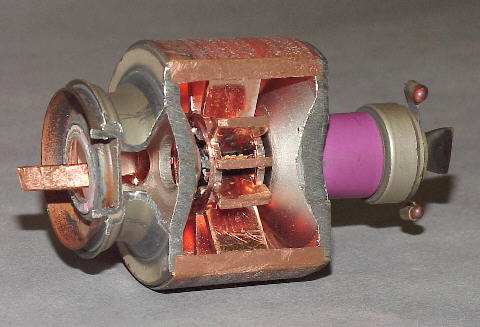The Subcontinent’s Missile Race
 A quick history lesson. A quarter of a century ago, the US (and NATO) were engaged in an unprecedented nuclear arms build-up in Europe that was initiated with the deployment of the SS-20 Sabre (NATO)/RT-21M Pioneer (Russia) IRBM in 1976. Unlike the much older SS-4 and SS-5 IRBMs, employed in 1959 and 1961, the SS-20 was a modern, road-mobile, MIRV’d missile with a CEP of 150m. In a word – it was a game changer when all 405 were ddeployed by 1986. The most significant and troublesome aspect of the SS-20 was that it was clearly a first strike weapon, meant for a swift strike against NATO leadership and theater nuclear forces, or TNF which mostly consisted of short- and medium range aircraft and Pershing I missiles.
A quick history lesson. A quarter of a century ago, the US (and NATO) were engaged in an unprecedented nuclear arms build-up in Europe that was initiated with the deployment of the SS-20 Sabre (NATO)/RT-21M Pioneer (Russia) IRBM in 1976. Unlike the much older SS-4 and SS-5 IRBMs, employed in 1959 and 1961, the SS-20 was a modern, road-mobile, MIRV’d missile with a CEP of 150m. In a word – it was a game changer when all 405 were ddeployed by 1986. The most significant and troublesome aspect of the SS-20 was that it was clearly a first strike weapon, meant for a swift strike against NATO leadership and theater nuclear forces, or TNF which mostly consisted of short- and medium range aircraft and Pershing I missiles.
The primary puropse of NATO’s TNF was to serve as a gap filler between conventional forces already ddeployed in Europe and arrayed against a numerically superior Warsaw Pact. In the nuclear calculus of the time, the survivability and hence, credibility of the TNF deterrent to a Warsaw pact invasion was now markedly reduced. The Carter Administration, after much public angst, first promised and then withdrew an offer of deployment of the Enhanced Radiation Warhead (the so-called “neutron bomb”) which did nothing to aid the perception of a weakening US commitment to NATO. Finally, in following the Soviet invasion of Afghanistan in 1979, the Carter Administration agreed to the deployment of 572 missiles (100 Pershing II’s and 472 GLCMs) while working on a treaty to ban said weapons. The Reagan Administration pressed ahead and ddeployed the missiles in 1984 despite massive anti-nuclear rallies in Europe and at home in the US. Still, between the Reagan Administration and Mikhail Gorbachev on the Soviet side, a landmark treaty was signed on December 8, 1987. A signatory feature of the treaty was the elimination of an entire class of weapon and prohibition on future development of the same.
conventional forces already ddeployed in Europe and arrayed against a numerically superior Warsaw Pact. In the nuclear calculus of the time, the survivability and hence, credibility of the TNF deterrent to a Warsaw pact invasion was now markedly reduced. The Carter Administration, after much public angst, first promised and then withdrew an offer of deployment of the Enhanced Radiation Warhead (the so-called “neutron bomb”) which did nothing to aid the perception of a weakening US commitment to NATO. Finally, in following the Soviet invasion of Afghanistan in 1979, the Carter Administration agreed to the deployment of 572 missiles (100 Pershing II’s and 472 GLCMs) while working on a treaty to ban said weapons. The Reagan Administration pressed ahead and ddeployed the missiles in 1984 despite massive anti-nuclear rallies in Europe and at home in the US. Still, between the Reagan Administration and Mikhail Gorbachev on the Soviet side, a landmark treaty was signed on December 8, 1987. A signatory feature of the treaty was the elimination of an entire class of weapon and prohibition on future development of the same.
Unfortunately, that prohibition didnot extend to other countries, nor to “collaborative” efforts.
 Fast forward to today. Relatively unnoticed by the rest of the world (save a handful of defense -centric specialty e-zines) a full blown missile race is underway on the Asian subcontinent between India and Pakistan, the latest iteration of which features development and deployment of nuclear capable land-attack cruise missiles, one layer of which was revealed today in a failed BrahMos LACM (land attack cruise missile) test:
Fast forward to today. Relatively unnoticed by the rest of the world (save a handful of defense -centric specialty e-zines) a full blown missile race is underway on the Asian subcontinent between India and Pakistan, the latest iteration of which features development and deployment of nuclear capable land-attack cruise missiles, one layer of which was revealed today in a failed BrahMos LACM (land attack cruise missile) test:
NEW DELHI: The Army’s endeavour to induct the BrahMos supersonic cruise missile as “a precision-strike weapon” took a hit on Tuesday, with the missile failing to achieve laid-down parameters in a test.
This comes at a time when the Pakistan Army is galloping ahead in inducting its nuclear-capable Babur land-attack cruise missile (LACM) – developed with China’s help to have a strike range of over 500 km – in large numbers into its arsenal. (The Economic Times)
The BrahMos is a joint Indian-Russian venture to build a family of supersonic cruise missiles able to be launched from sea or shore. Following the model previously established by the 5 recognized nuclear powers (US, Russia, France, Britain, China), India is pursuing a nuclear variant as the primary version of the LACM. This effort is in parallel with ongoing work on the Agni family of MRBM/IRBMs with the latest, the Agni III ranging far enough to strike almost any target in China, Pakistan and the Middle East or Russia.
 For its part, Pakistan is busy with the road-mobile Ghauri (1500 km, single stage, liquid-fueled) and Shaheen II (2500 km, 2-stage, solid fueled) MRBMs and the LACM known as the Babur (“Lion”), which is being developed with their Chinese partners and bears a more than passing resemblance to the Tomahawk cruise missile in both physical appearance and attributes such as its navigation package. The same, incidentally, may be said of China’s DongHai-10 (DH-10) LACM and given the number of Tomahawks fired in the Middle East and in Bosnia, it wouldn’t be surprising if components hadn’t made their way back to China for re-engineering. Nevertheless, the 2007 surprise test of the nuclear variant of the Babur caught India by surprise and has had the effect of speeding up the BrahMos program.
For its part, Pakistan is busy with the road-mobile Ghauri (1500 km, single stage, liquid-fueled) and Shaheen II (2500 km, 2-stage, solid fueled) MRBMs and the LACM known as the Babur (“Lion”), which is being developed with their Chinese partners and bears a more than passing resemblance to the Tomahawk cruise missile in both physical appearance and attributes such as its navigation package. The same, incidentally, may be said of China’s DongHai-10 (DH-10) LACM and given the number of Tomahawks fired in the Middle East and in Bosnia, it wouldn’t be surprising if components hadn’t made their way back to China for re-engineering. Nevertheless, the 2007 surprise test of the nuclear variant of the Babur caught India by surprise and has had the effect of speeding up the BrahMos program.
he upshot of this sub-continental arms race is a host of potentially bad news for the US. There are all sorts of lines of intersection between US interests int he region, whether it be the tribal regions along the Pakistani-Afghani border, technology and/or arms proliferation to Iran, the US-Indian nuclear reactor deal, growing Chinese presence along the Silk Road into the ‘stans and proximity to Indian territorial claims, and not least of which is the fact these two countries have twice inside the last half-century engaged in fierce, bloody warfare. Leavening that frightful mix with the yeast of nuclear missile arms race is daunting at best.
Facing an already overwhelming foreign policy agenda, one wonders if the new Administration and its new Secretary of State will notice, much less take an active interest in working to stem this race. Building on the INF model, if taken, is only a partial solution as the proliferation of weapons on the margins of- and in this category is any indicator. In any event, absent significant technological setbacks or exceptional diplomatic effort, the region appears to be well on its way to seeing significant operational forces deployed within a few years, adding another un-needed strand of complication to a region already binding itself into a Gordian knot.




Great. Now I have a reason to get an early beer.